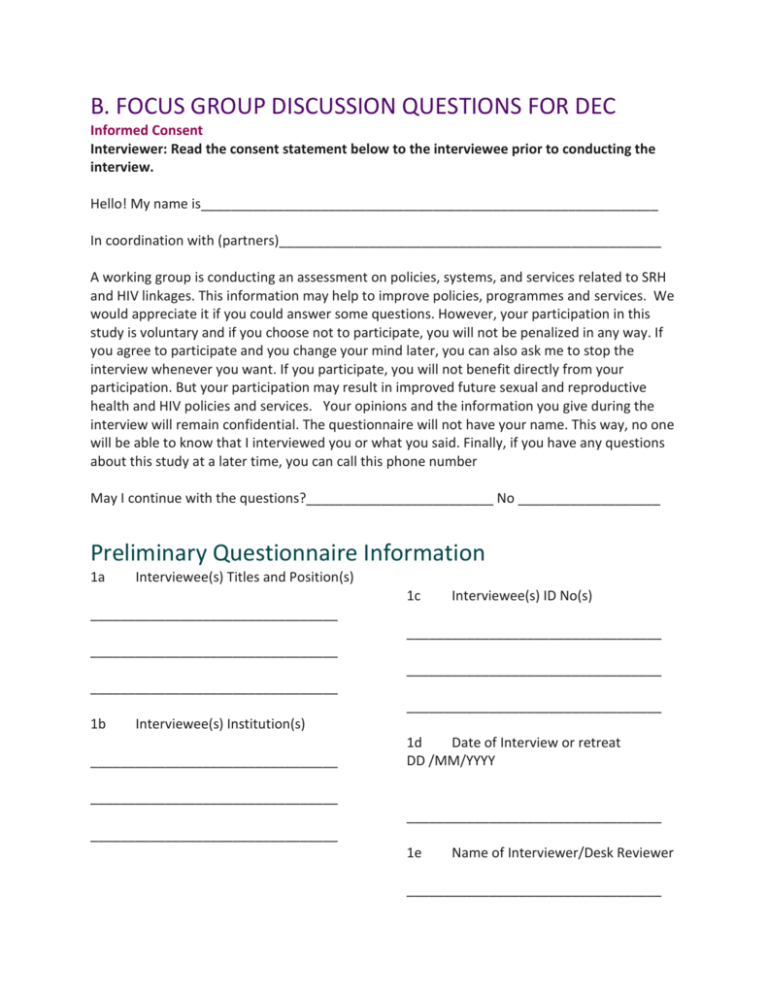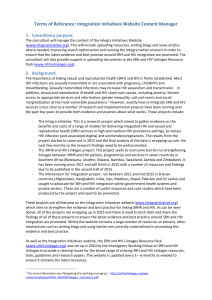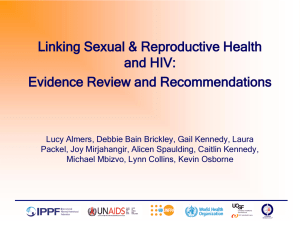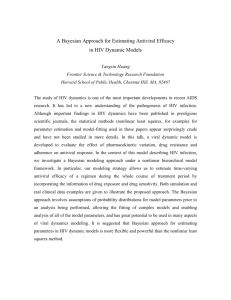Malawi baseline assessment: Focus
advertisement

B. FOCUS GROUP DISCUSSION QUESTIONS FOR DEC Informed Consent Interviewer: Read the consent statement below to the interviewee prior to conducting the interview. Hello! My name is_____________________________________________________________ In coordination with (partners)___________________________________________________ A working group is conducting an assessment on policies, systems, and services related to SRH and HIV linkages. This information may help to improve policies, programmes and services. We would appreciate it if you could answer some questions. However, your participation in this study is voluntary and if you choose not to participate, you will not be penalized in any way. If you agree to participate and you change your mind later, you can also ask me to stop the interview whenever you want. If you participate, you will not benefit directly from your participation. But your participation may result in improved future sexual and reproductive health and HIV policies and services. Your opinions and the information you give during the interview will remain confidential. The questionnaire will not have your name. This way, no one will be able to know that I interviewed you or what you said. Finally, if you have any questions about this study at a later time, you can call this phone number May I continue with the questions?_________________________ No ___________________ Preliminary Questionnaire Information 1a Interviewee(s) Titles and Position(s) 1c Interviewee(s) ID No(s) _________________________________ __________________________________ _________________________________ __________________________________ _________________________________ __________________________________ 1b Interviewee(s) Institution(s) _________________________________ 1d Date of Interview or retreat DD /MM/YYYY _________________________________ __________________________________ _________________________________ 1e Name of Interviewer/Desk Reviewer __________________________________ A. Partnerships ITEM No. 2 3 4 5 6a 6b 6c 7a 7b 7c 7d 7e 7f 8 QUESTION Who are the major development partners for the SRH programme? Who are the major development partners for the HIV programme? Who are the major champions supporting (policy, financial and/or technical) SRH and HIV linkages? Is there any multi-sectoral technicalgroup working on linkages issues? What is the role of civil society in SRH programming (in particular networks of PLHIV)? What is the role of civil society in HIV programming (in particular networks of PLHIV)? What is the capacity of PLHIV organizations and networks? i.e. do they have proper structures and/or skills? Are PLHIV involved in both the SRH and HIV responses and programming? Are young people involved in both SRH and HIV responses and programming? Are Networks or associations of key populations, (e.g. SWs, IDUs, MSM) involved in both SRH and HIV responses and programming? Are people with disabilities, (blind, lame, mentally disturbed etc) involved in both SRH and HIV responses and programming? Are women groups involved in both SRH and HIV responses and programming? Are professional associations involved in both SRH and HIV responses and programming? How are organizations of young people involved in responses to HIV and in SRH programming? Possible prompts: Part of situation analysis? Part of planning? Part of budgeting? Part of implementation? Part of evaluation? 2|Page RESPONSE COMMENTS B. Planning, Management and Administration ITEM No. 9a 9b QUESTION Is there joint planning of HIV and SRH programmes? (If yes) How is joint planning of SRH and HIV programmes undertaken? (For example,dual protection in condom programming,the HIV National Strategic Plan, proposals for the Global Fund, integration of HIV into poverty reduction strategy papers). Possible prompts: DDP and DAC, do they look at SRH issues in their project evaluations? How do they incorporate gender interests? 9c (If yes) Are people from HIV programmes involved in the SRH planning process? Possible prompt: Does the SRH department of the MOH include members of the national HIV coordinating body? 9d (If yes) Are people from SRH programmes involved in the HIV planning process? Possible prompt: Is there any collaboration between SRH and HIV for programme management/implementation? 10a 10b Is there any collaboration between SRH and HIV for programme management/implementation? (If yes) Provide examples. Possible prompts: Coordination of activities? i.e how do SRH and HIV coordinators collaborate? Monitoring activities? How is the data integrated? Integrated supervision of activities? Integrated budgets? Do they itemize tools/equipment that can be used for both services? 11a To what extent have the following SRH services integrated HIV and have HIV services integrated SRH? Examples of SRH Services are: 1. Family planning 2. Prevention and management of STI s 3. Maternal and newborn care 4. Prevention and management of gender-based violence 5. Prevention of unsafe abortion and management of postabortion care 3|Page RESPONSE COMMENTS Examples of HIV services are: 1. HIV counselling and testing 2. P rophylaxis and treatment for PL HIV (OI s and HIV ) 3. Home-based care 4. Psycho-social support 5. Prevention for and by people living with HIV 6. HIV prevention information and services for general population 7. Condom provision 11b What institutions are providing integrated services for HIV and SRH? Possible prompts and practical examples from: Government facilities? NGO s? Faith-based organizations? Community-based organizations? Private sector? CHAM? 30 31 C. Staffing, Human Resources and Capacity Development ITEM No. 12 QUESTION What are some of the highest priority training needs, i.e. who needs to be trained on what subjects or skills? (See sample table in Appendix 4 for health sector) 13 Does capacity building on SRH and HIV integrate guiding principles and values? Possible prompts and please give practical examples to demonstrate how the principle, value is promoted: Avoidance of stigma and discrimination? Gender sensitivity? Male involvement? Attitudes towards key populations? Attitudes towards PL HIV ? Confidentiality? Youth-friendly services? Reproductive rights and choices? 14a 14b 14c 4|Page Are there training materials and curricula on SRH which include HIV prevention, treatment and care at programme and service-delivery levels and as part of pre-service training? (please ask to see copies if necessary) ... As part of in-service training? Are there training materials and curricula on HIV which include SRH at programme and service- RESPONSE COMMENTS 14d delivery levels and as part of pre-service training? ... As part of in-service training? Possible prompts: For community outreach workers? For health-care providers? CBDA’s HAS’s TBA’s 14e 14f 14g 15 16a 16b 16c 16d ... How often do these trainings take place? ... Who initiates the trainings? ... What is the gender segregation at the trainings? Are curricula and training materials revised and updated regularly? (refer to manual seen in 14a) Does late primary and/or secondary education and/or teacher-training curricula incorporate SRH and HIV at the levels mentioned below? Late primary? Secondary education? Teacher training? Possible prompts: Safer sex? Sexual health? Empowerment? (How is empowerment achieved) Stigma? Gender-based violence? Condoms? (for both male and female) Rights and responsibilities? 17a In relation to staff for SRH and HIV programmes, what are the biggest challenges? Possible prompts: Retention? Recruitment? Task shifting? Workload and burnout? Quality? Motivation? 17b 17c How has the integration of services influenced these challenges? (refer to challenges mentioned in 17a) What solutions have you found to those challenges? 32D. Logistics/Supplies ITEM No. 18 QUESTION To what extent do logistics systems support or hinder effective service-delivery integration? Possible prompts: 5|Page RESPONSE COMMENTS Separate supply system for HIV and PHC/SRH? Planning and supply of commodities (e.g. condoms, drugs) for both HIV and SRH? Separate recording and monitoring of SRH and HIV ? / 1325 E. Laboratory Support ITEM No. 19 QUESTION RESPONSE COMMENTS Do laboratory facilities in the district serve the needs for both SRH and HIV services? Possible prompts: Haemoglobin concentration? Blood grouping and typing? STI diagnosis, including RPR /VDRL (for syphilis)? HIV diagnosis, including rapid tests? CD 4 count? HIV Viral load? Liver function tests? Urinalysis? Random blood sugar? Pregnancy testing? (please mention the hospital that has it in the district) F. Monitoring and Evaluation ITEM No. 20a QUESTION How do the monitoring and evaluation structures capture results of integration in SRH programmes? Possible prompts: Access to services? Uptake of services? Quality? Client satisfaction? Client profile? (Please explain what has changed) 20b 21a How do the monitoring and evaluation structures capture results of integration in HIV programmes? Possible prompts: (as above) What indicators are being used to capture integration between SRH and HIV and are they adequate in HIV programmes? (please ask to see a copy of the document) Possible prompts: HIV clients receiving SRH services? SRH clients receiving HIV services (e.g. % of FP clients 6|Page RESPONSE COMMENTS offered HIV counselling and testing)? (e.g. % of HIV -positive clients who receive support to achieve their fertility choices or who receive support to address socio-economic challenges)? 21b 22 What indicators are being used to capture integration between SRH and HIV and are they adequate in SRH programmes? (Please ask to see a copy of the document) Possible prompts: (as above) To what extent does supportive supervision at the health service-delivery level support effective integration? (Please ask to see the tool) Possible prompt: Is there a tool for integrated supervision available (e.g. checklist)? 23 Are data collected on SRH and HIV disaggregated by sex, age and HIV status? Possible prompts: What are the respective ages for a) females and b) males with respect to: i) A ge of majority age at first sexual intercourse? ii) L egal age of marriage? iii) O ther demographic categories? 7|Page




